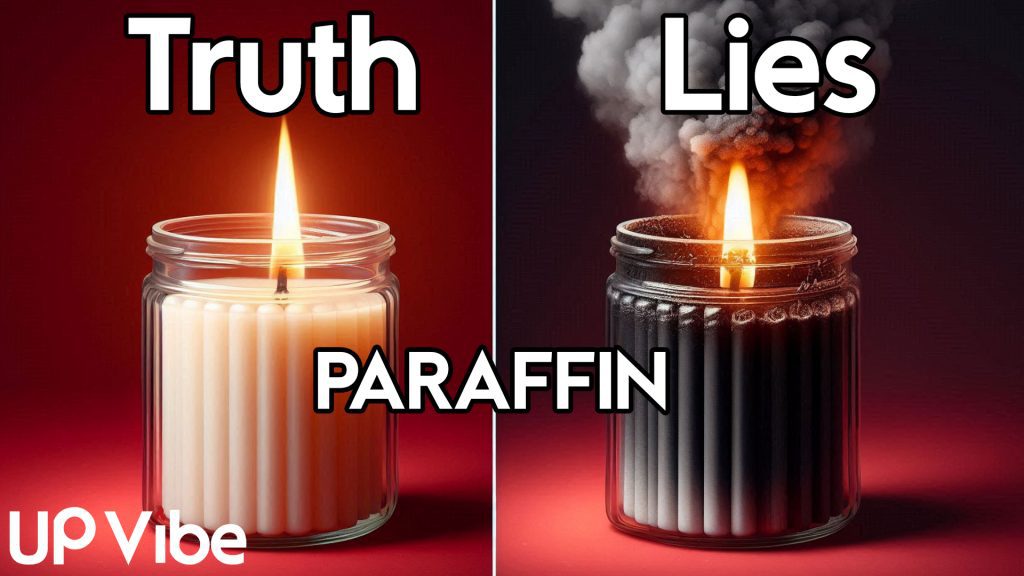
The Truth About Paraffin Wax: Myths, Facts, and What You Need to Know
Let’s talk about the real truth about paraffin wax.
There are so many misconceptions and myths that get repeated when it comes to paraffin wax. But what are the actual lies? What do successful paraffin candle makers know that you don’t?
Paraffin wax might not be as bad as you think… or maybe it is. Let’s find out!
What is Paraffin Wax?
Paraffin wax gets a bad rap, but scientific research from the National Library of Medicine indicates that “under normal conditions of use, scented candles, including those made from paraffin, do not pose known health risks to consumers.”
And whether you know it or not—or like it or not—paraffin is almost completely unavoidable.
But what exactly is paraffin?
My wife works for a major crude oil refinery, and she helped me break down the refining process. I’ll warn you—it’s a bit dense, but I’ve simplified it for you (and for me… because I’m blonde).
How Paraffin Wax is Made
-
Crude Oil Extraction – Paraffin comes from crude oil, which is pumped out from underground and sent to a refinery.
-
Fractional Distillation – The crude oil is heated in a distillation column, separating it into different components. Paraffin wax is found in the middle distillate fraction.
-
Solvent Dewaxing – A solvent is mixed with the oil and cooled to solidify the wax, which is then filtered out.
-
Hydrotreating – The wax is treated with hydrogen gas at high temperatures to remove impurities like sulfur and nitrogen.
-
Decolorization – Activated charcoal or clay absorbs color and any remaining impurities, making the wax white and clear.
-
Final Processing – The purified wax is polished and blended with other waxes or additives to adjust hardness, melting point, and fragrance compatibility.
Phew! That was a lot, but now that we understand paraffin wax, let’s debunk some common myths.
Myth #1: Paraffin Wax is Inferior to Other Waxes
While eco-friendly waxes like soy, coconut, and beeswax are gaining popularity, paraffin wax is still the most widely used. Many major brands, like Yankee Candle, Bath & Body Works, and Glade, use paraffin as their primary wax choice.
Why?
-
Cost-Effective – It’s often more affordable (but not always—more on that in a moment).
-
Strong Scent Throw – It holds and releases fragrance well.
-
Widely Available – Found in most parts of the world.
-
Versatile – Can be molded into various candle designs.
Myth #2: Paraffin is Always Cheaper
It’s true that paraffin is generally cheaper, but high-quality paraffin isn’t much cheaper than soy, coconut, or beeswax.
For example, as of now:
-
Paraffin Container Wax (MP-117) – $106.78 for a 44lb case
-
Golden Brands 464 Soy Wax – $103.30 for a 45lb case
That’s only a $3.48 difference!
Now, if you’re buying low-quality paraffin (think dollar store candles), then yes, you’ll see a huge price gap. But high-quality paraffin is not drastically cheaper than other waxes.
Myth #3: Paraffin is Unsafe
This one is both true and false. Here’s why:
-
The National Candle Association states that all quality candle waxes—paraffin, soy, coconut, palm, beeswax, gels, and synthetic waxes—burn cleanly and safely.
-
The keyword? Quality. Lower-quality paraffin can contain impurities that may cause more soot or irritate sensitive individuals.
-
Some people experience headaches, allergies, or irritation from paraffin candles, but this is often due to added fragrances or dyes—not the wax itself.
That said, all candles (regardless of wax type) release some level of VOCs (volatile organic compounds), so moderation is key.
Myth #4: Paraffin is the Oldest Candle Wax
Nope! Paraffin wax has only been used in candles since the 1800s. Before that, candles were made from:
-
Tallow (animal fat) – Cheap, used for everyday lighting.
-
Beeswax – Cleaner burning, used in religious ceremonies and special occasions.
Paraffin became popular because it was cheap and burned consistently, but it’s far from the oldest candle wax.
Myth #5: Paraffin Causes More Soot
A common misconception is that paraffin candles produce more soot than other waxes. The truth?
Soot isn’t just about the wax—it’s about wick size, fragrance load, and burn conditions.
-
Quality paraffin produces minimal soot when burned properly.
-
Wick size matters – An oversized wick can cause excess soot.
-
Too much fragrance oil can lead to incomplete combustion.
-
Trimming the wick regularly keeps any candle burning clean.
Myth #6: Paraffin Has the Best Scent Throw
This one is tricky because scent throw is subjective—like arguing about the best pizza.
(Spoiler: NYC has the best pizza. If you disagree, take your hand, put your thumb in your mouth, blow several times, remove your hand, and slap yourself.)
Anyway, paraffin is often considered the best for scent throw because it holds fragrance well and releases it effectively. But soy, coconut, and beeswax can also throw scent well when formulated properly.
So, is paraffin the best for scent throw? That depends on you.
Final Thoughts
Paraffin wax is not the enemy—it’s just one of many options for candle making. If you’re looking for strong scent throw, affordability, and versatility, it’s a great choice. If you prefer more eco-friendly alternatives, soy, coconut, and beeswax are solid options too.
At the end of the day, it’s about quality, formulation, and personal preference.
What do you think? Do you use paraffin in your candles, or do you prefer another wax?
If you’d like to see the full video version please click here.



0 Comments